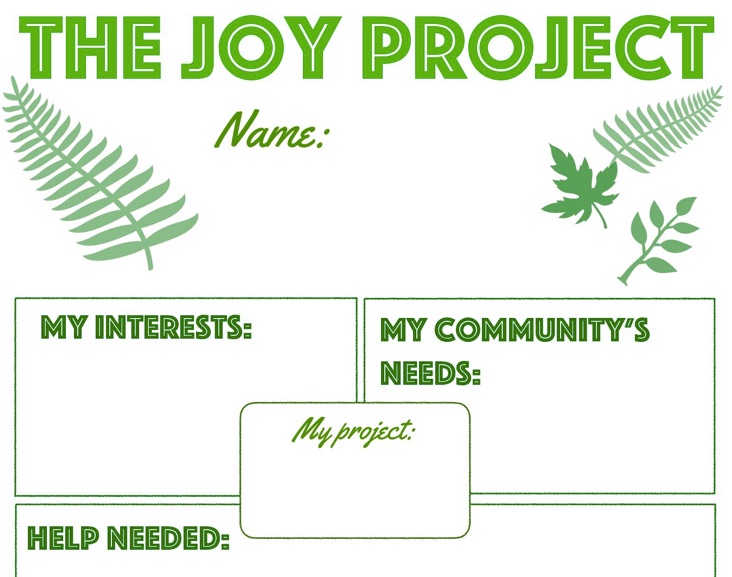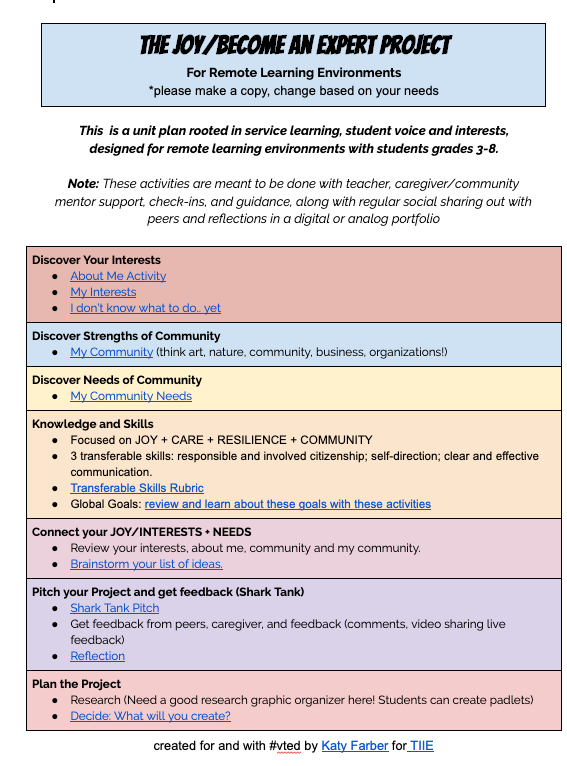JOY + CARE + RESILIENCE
Co-written by Audrey Homan and Katy Farber
Lots of educators, students and families are telling us that we can’t simply replicate in-classroom learning via video conferencing and assignments. It is *too* much for teachers and students and families. It doesn’t offer the kind of hands-on learning we know students enjoy, along with the flexibility families need in this moment.
Plus, students need more joy and creativity to build up their sense of selves, their resilience, and their connections to the world.
A student-driven, thematic project could provide this.
Hear us out: it’s time for Joy Projects.
You may have heard the terms before: genius hours, passion projects, curiosity projects. But for this moment in time, we feel like we need:
- a student-driven interest-based project
- that can be done remotely
- featuring analog and virtual options
- focused on JOY + CARE + RESILIENCE
Take a moment with that idea, because it’s a big one.
How can educators and families support students in doing personal interest projects done with flexibility, creativity and curiosity? What kind of guidelines could students use to provide structure and direction for passion-based learning?
The Basic Recipe: 7 Steps to Joy
We want to help educators and students do personal interest projects that feature the following seven steps.
1. Discover your interests
Students, what brings you joy during this time? What do you want to explore? Will your Joy Project be wide open and free choice? Or will you focus mostly on one subject area, or a Global Goal, or a student-determined theme? And educators, what kind of joy do you see relating to where your students were, as a group, or where you’re all going on this new journey?
2. Discover your community.
Who are the people around you? And who do you see pulling together as a community right now, what do you notice happening? Who is in your community during this challenging time, and what are some of their strengths and some of their needs?
3. Find the overlap.
This one’s key: where are the places where your interests as a learner overlap with the needs of your community? Think of this in terms of finding a key that unlocks learning in your community, or that of your students. Your community’s needs are a lock; when the needs are met, they unlock better health and happiness in the community. Your learning interests are a key: you can use them to unlock that better health and happiness.
4. Enlist help.
We are all stronger together: as you undertake this learning project, who are some of the people or organizations in your community who can provide you with support. Are they some of the same people with the needs you’re trying to meet? Or, are they people who simply have strengths that you may not have explored, who could lean in a little?
5. Choose a reflection.
As you learn, you’re going to want to keep track of what you’re learning along the way. You could use a learning journal, or a scrapbook. You could create a podcast, or start a YouTube channel. Or could you could free-write, or explore mixed media? Or create a class padlet for all the students in the group to document their learning? Choose a method in advance, then…
6. Get it on the calendar
While learning is a lifelong process, let’s put some milestones down, and make the wide-open unknown of time work for student learning. Will you do a month-long project? A semester-long one? Are you a student who just wants to take a week to explore one of your passions, then a break, then take another week to explore something different? Set your boundaries.
And as you set your schedule, keep that end date in sight, and plan for how you want to share this learning. And who will you share it with? Are you a class of learners who want to gather in Zoom? A student who wants to write an article for the local paper? Do you want to record a TED Talk, or conclude your podcast series? Will you send your podcast to the local radio station, or just share it on your family website? Will you snail-mail your journal to a far-away beloved relative? Choose a method, then set and share the date.
7. Do the work (learn + create).
This is the funnest part! Now you have a plan for what you want to do, get in there and follow your passion. Help your community. Be the change.
Some examples:
Perhaps you’re an educator whose class was studying Lake Champlain when All This happened.
Host a discussion with your students as to how they want to use the seven steps to structure a two-week culminating project around their own personal explorations of the lake. You might set three check-in points for students along the way, taking them to the calendar in your Google Classroom, and ask students to contribute their learning to a shared padlet. Perhaps one of your students videos his interpretive dances about the lake and adds those to the padlet. Another student writes long-form in a journal about observing the aquatic snails at the shoreline. You’ve informed families of the date for the share-out gala, which they can enjoy from their own homes.
Or perhaps you’re a student, working on family meals.
You’ve always been interested in gourmet breads, and a little online research has led you to be curious about cardamom buns, or Georgian khachapuri, or discovering the recipe for your grandmother’s cast-iron no-knead bread. You announce May 2020 as The Month Of Breads. As you experiment with different bakes, you snap a quick photo, and email around a quick survey to the members of your household (yes, you have to transcribe your little sister’s answers, in that you ask her in an interview style). You add your own thoughts and research and combine the whole in a Google folder. You’ve promised your family and classmates a cookbook for the end of school. Not everything’s delicious, but you learn more every time.
Maybe you’ve always wanted to learn a new language.
You’re a busy caregiver working from home and staring at your children. One of them showed you the free option for studying Hebrew in Duolingo. You scrolled through and talked over what could be learned in six weeks time. A little negotiation while prepping the garden bed and you get to check in with your student weekly, seeing their progress on the leaderboards and the points they accrue. Your student also reached out to their rabbi and the rabbi made some suggestions for additional materials to try. They’ve been looking for someone to help translate some materials online. The rabbi promises to speak with your scholar next time you go to temple.
Grow into your joy.
You own a nursery and now is GO TIME, corona or no. As your nursery runs on child labor (ahem), you and your student talk about how said student could be in charge of the strawberry starts this year, from incubation through to marketing. You show them the accounting software you use, and set them up with an account. They tell you their love of jam, and the two of you look at what it could look like to incorporate the added-value product to your farmstand for the official start of the CSA season.
And SCENE. It’s Joy time, y’all.
Options options options
- The project could be broken down in a slide show format, which could be reviewed on a phone, and completed in a journal, notebook, or Word document.
- Project pages could be printed off and stapled, delivered to students, and used as a place to gather reflections and learning for the entire project.
- Also, what about Google Docs that could be printed and distributed as a passion project with phone check-ins?
- To simplify, students could use one place to record their Joy Project experience. Preferably their PLP! Seesaw works well for this, as it is a digital journal and could be used for students to post updates about their progress.
- Students could also create reflections right in a slide show version of this, if they have their own student copy. And then post this to their PLP.
- Or lastly, they could create a digital way to share, like Book Creator, about this project, and post on their PLPs.
Structure structure structure
Here’s a full-fledged, education-forward Google Doc template with all the bells and whistles you need to craft deeply personalized, service learning-oriented personal interest projects with students. If that’s what brings you (and them) joy.
And here’s a simplified .pdf template that just contains the seven essential elements.

Advice for educators on Joy Projects
If this feels a little daunting, totally feel free to use our service learning template, completed and revised for this moment, that you can use with or as a learner. It’s the full-featured item, and will work best for teachers or teaching communities. And you absolutely can reach out to us here with questions or concerns.
But we bet you’ll see so many connections between this project and service learning that the whole project can be designed around the idea of using your interest/joy to benefit your community. You got this.
Advice for caregivers
We know you are busy. My goodness. If your school is not providing a structure like this, you can do this, and either check in with your student to provide feedback and structure, or invite a friend, an elder, or someone who knows a bit about the subject area to provide support, feedback and an audience.
Start the day with a quick check in to help your child focus on what part of the project they will work on that day, with small, doable, engaging tasks. Have them record their project progress back to you at the end of the day, with a photo and a caption, describing what they did today, what they learned and what they want to do next.




One Reply to “Introducing: The Joy Project”
Comments are closed.